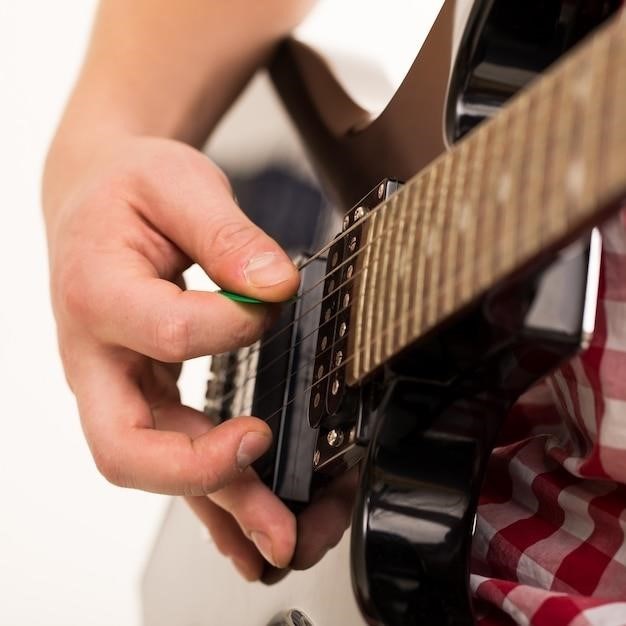7-String Guitar Guide⁚ A Comprehensive Overview
This guide explores the world of 7-string guitars, covering setup, tuning, string choices, and playing techniques. From standard tuning to advanced techniques, discover resources and tips for mastering this extended-range instrument and various musical genres.
Understanding the 7-String Guitar
The 7-string guitar, an extension of the standard 6-string, adds a lower string, typically tuned to B, significantly expanding the instrument’s sonic range. This additional bass string opens up new possibilities for lower-register playing, particularly appealing to genres like metal and progressive rock where deep, heavy tones are desired. The extended range allows for richer harmonies and more complex chord voicings, pushing the boundaries of musical expression. While initially challenging for players accustomed to 6-strings, the benefits of the 7-string guitar are undeniable, particularly in the realm of heavier music. The low B string provides a powerful foundation for riffs and solos, adding a unique depth and texture to the overall sound. However, mastering the 7-string requires adaptation, including adjusting playing techniques and potentially altering chord shapes to accommodate the additional string. Many players find the extended reach and wider fretboard demanding at first, but with practice, the rewards of this versatile instrument are well worth the effort. The learning curve may be steeper than that of a six-string, but the unique musical possibilities make the journey a rewarding one. The 7-string guitar opens a world of sonic exploration, pushing creative boundaries for both seasoned and aspiring musicians.

Standard Tuning and its Advantages
The standard tuning for a 7-string guitar is a logical extension of standard E tuning for a 6-string. It maintains the familiar intervals of a standard 6-string while adding a low B string below the low E. This tuning (B, E, A, D, G, B, e) offers several advantages. Firstly, the consistent intervallic relationships between strings make transitioning from 6-string to 7-string easier. Chords and scales learned on a 6-string often translate directly, requiring minimal adaptation. Secondly, the low B string provides a powerful foundation for heavier genres, offering a deep, resonant tone ideal for drop tunings and extended low-end soundscapes. This is a significant advantage for players of metal, progressive rock, and other genres that utilize lower tunings. Thirdly, the standard tuning facilitates easy access to a wide tonal range, allowing for both low-end heaviness and soaring high notes. This versatility makes the 7-string adaptable to various musical styles. While many alternative tunings exist for 7-string guitars, starting with the standard tuning provides a strong foundation for exploring different techniques and expanding your musical palette. Its familiarity and versatility make it an excellent starting point for any 7-string guitarist. The consistent intervallic structure makes it a solid launching pad for learning more complex tunings.
Popular 7-String Guitar Tunings
Beyond the standard B-to-e tuning, the 7-string guitar offers a world of alternative tunings to explore. Drop tunings, where one or more strings are lowered a whole or half step, are popular choices for heavier genres. Drop A tuning (A, E, A, D, G, B, e), for instance, lowers the lowest string to A, creating a heavier, more guttural sound often favored in metal subgenres. Open tunings, where all strings are tuned to create an open chord, are equally appealing for creating unique textures and soundscapes. These tunings can be particularly effective for creating ambient or atmospheric music. Experimentation with open tunings can yield unexpected and creative results. For those seeking a more experimental approach, various alternative tunings exist, often involving microtonal intervals or non-standard string arrangements. These tunings can significantly alter the instrument’s character and lead to sounds that are vastly different from traditional guitar sounds. Exploring these tunings requires a willingness to experiment and break away from the confines of traditional approaches. The choice of tuning often depends on the genre and the individual player’s stylistic preferences. Remember, the possibilities are vast, offering a playground for creativity and musical exploration. The key is to experiment and discover what sounds best to you.
Setting Up Your 7-String Guitar⁚ Action and Intonation
Setting up a 7-string guitar involves adjusting the action (string height) and intonation (pitch accuracy across the fretboard). Proper action ensures comfortable playability and prevents string buzzing. Too high an action makes playing difficult; too low leads to fret buzz. Adjusting the action typically involves altering the bridge height and neck relief. Intonation ensures that the notes played across the fretboard are in tune. Inaccurate intonation results in notes sounding out of tune, especially higher up the neck. Adjusting intonation usually involves altering the saddle position on the bridge. Both action and intonation are interdependent. Altering one can necessitate readjusting the other to achieve optimal playability and sound. Using a reliable tuner is crucial for precise intonation checks. Many resources are available online, offering step-by-step guides and videos to aid in the setup process. However, if you lack experience, it’s wise to seek professional help from a qualified guitar technician. They possess the expertise and specialized tools to set up your 7-string correctly, ensuring optimal performance and minimizing the risk of damage to your instrument.
Choosing the Right Gauge Strings
Selecting the appropriate string gauge for your 7-string guitar significantly impacts playability and tone. Gauge refers to the thickness of the strings, typically measured in thousandths of an inch. Heavier gauges (thicker strings) produce a fuller, richer tone with increased tension, but can be more challenging to play, especially for beginners. Lighter gauges (thinner strings) are easier to bend and play, resulting in a brighter, less powerful sound. The choice depends on your playing style and preferred genre. For genres like metal, heavier gauges are often preferred for their robust tone and ability to withstand aggressive playing. For genres such as jazz or funk, lighter gauges might be favored for their flexibility and ease of bending. Experimentation is key; try different gauges to find your ideal balance between tone, feel, and playability. Consider the scale length of your guitar, as this influences string tension. Longer scale lengths generally require heavier gauges to maintain adequate tension. Online resources and forums offer valuable insights and recommendations from experienced 7-string players, sharing their preferred gauges for various musical styles and playing techniques. Remember to always properly stretch new strings before tuning to prevent breakage. Choosing the right gauge strings is a vital step in optimizing your 7-string guitar’s performance.
Online Tuning Resources and Tools
In today’s digital age, numerous online resources simplify the process of tuning a 7-string guitar. These tools offer significant advantages over traditional tuning methods, providing accuracy and convenience. Many websites and apps provide chromatic tuners, allowing you to tune each string individually to its precise pitch. These digital tuners often feature visual and auditory feedback, making it easy to identify and correct inaccuracies. Some online tuners offer various tuning options beyond standard B-standard tuning, accommodating alternate tunings often used in different genres. The convenience of these online resources is undeniable; you can tune your guitar anywhere with an internet connection or on your mobile device. Several apps even allow you to store custom tunings, beneficial for players who frequently switch between different settings. While many free online tuners are available, paid versions frequently offer enhanced features such as more precise tuning algorithms and additional functionalities. Before relying solely on an online tuner, it’s beneficial to familiarize yourself with basic tuning techniques to ensure accuracy and to troubleshoot potential issues if your online resources prove unreliable. Explore different online tuners to find one that suits your needs and preferences, enhancing your 7-string playing experience.
Troubleshooting Common 7-String Issues
Seven-string guitars, while offering expanded musical possibilities, present unique challenges. A common problem is buzzing strings, often caused by high action (the distance between the strings and the frets). Adjusting the truss rod, a metal rod within the neck, can alleviate this. If buzzing persists despite truss rod adjustment, the bridge may need attention. Incorrect intonation, where notes are out of tune, particularly on the lower strings, can be frustrating. Intonation is adjusted using the bridge saddles, requiring careful tweaking and retuning until all notes ring clearly across the fretboard. String breakage is another concern, often linked to using incorrect string gauges or aggressive playing styles. Choosing strings appropriate for your playing style and the guitar’s specifications is crucial. Another frequent issue is tuning instability, particularly affecting the low B string. This can be due to several factors, including improper string stretching and poor tuning peg lubrication. Regular maintenance and using a high-quality string winder can help prevent this; Lastly, fret wear can also impact playability and tone, especially with heavier gauges or aggressive playing. Addressing fret wear might require professional fret leveling and dressing. Remember, maintaining your seven-string guitar through regular setup and maintenance is key to avoiding these common issues and ensuring optimal playing conditions.
Caring for Your 7-String Guitar
Proper care ensures your 7-string guitar’s longevity and optimal performance. Regular cleaning is essential; wipe down the body and neck after each playing session with a soft, dry cloth. For more thorough cleaning, use a guitar-specific cleaning solution and a microfiber cloth, avoiding harsh chemicals. Pay special attention to the fretboard, cleaning it gently with a fretboard cleaner or lemon oil. Store your guitar in a controlled environment, away from direct sunlight, extreme temperatures, and humidity. A hard-shell case offers superior protection, while a gig bag provides some level of safeguarding during transportation. Keep your guitar strings clean and free of dirt and grime. Regularly inspect your strings for wear and tear; replacing them when they show signs of corrosion or breakage is vital for optimal tone and playability. Proper string winding technique is crucial to prevent breakage and tuning issues. Avoid extreme force during tuning and ensure the strings are properly wound around the tuning posts. Periodic professional setup is recommended to address intonation, action, and overall playability. A well-maintained instrument not only sounds better but also remains stable and reliable, enhancing your playing experience for years to come. Remember, a little preventative care goes a long way in preserving your investment.
Playing Techniques for 7-String Guitars
Transitioning to a 7-string guitar requires adapting your playing techniques. While standard chords and scales translate, the added low B string opens new possibilities. Initially, focus on comfortable hand positioning, ensuring your fretting hand can easily reach all strings without strain. Practice simple exercises to build strength and dexterity, acclimating your fingers to the wider fretboard. Experiment with different picking techniques, adjusting your approach to accommodate the lower string’s increased tension and potential for string noise. Explore extended range techniques like drop tunings and alternate tunings to access unique sonic landscapes. Develop your left-hand technique to handle wider stretches and increased finger spacing, especially in chord voicings and arpeggios. The lower register offers opportunities for percussive rhythms and textural effects. Experiment with palm-muting and other percussive techniques to explore the unique characteristics of the lower B string. Incorporate the lower B string into your existing repertoire by adding bass lines, rhythmic patterns, and harmonic extensions. Listen to 7-string guitarists in various genres to observe phrasing and stylistic choices that utilize the extended range effectively. Remember, patience and practice are key to mastering the 7-string guitar’s unique playing demands, unlocking its expressive potential.
Recommended Brands and Models
The 7-string guitar market offers diverse options catering to various budgets and playing styles. Ibanez is a dominant player, renowned for its RG series, featuring models like the RG7321, prized for their playability and versatility. Their prestige line offers higher-end options with improved components. Schecter guitars provide another strong contender, known for their diverse range, including the Banshee and Hellraiser models, often favored for their aggressive tones and comfortable necks. Alternatively, consider exploring ESP’s LTD series, offering affordable yet high-quality instruments, suitable for beginners and experienced players alike. For those seeking a more custom approach, Kiesel Guitars offers highly customizable options, allowing players to tailor their instrument to their specific needs and preferences. Each brand offers varying levels of quality, features, and price points. Consider factors like neck profile, body wood, pickups, and hardware when making your choice. Reading online reviews and comparing specifications can greatly assist in finding a model that matches your musical style and preferences. Ultimately, the best 7-string guitar is the one that feels most comfortable and inspires you to play.
Exploring Different Musical Genres with a 7-String
The extended range of a 7-string guitar opens up exciting possibilities across various genres. In metal and its subgenres (death metal, progressive metal, etc.), the low B string provides a powerful foundation for heavy riffs and guttural sounds, enhancing the overall heaviness and sonic depth. Progressive rock and metal bands often utilize the extended range for complex chord voicings and textural experimentation, pushing the boundaries of musical expression. Jazz musicians are also exploring the 7-string’s potential, utilizing its extended range for unique harmonies and improvisational explorations, creating rich and nuanced soundscapes. Even in genres like alternative rock and indie rock, the 7-string can add a distinct sonic character, providing a heavier edge or unique textures. The versatility of the instrument allows for creative adaptations to diverse styles. Experimentation with different tunings further expands the sonic palette, providing a foundation for unique sounds and textures that challenge traditional genre boundaries. Ultimately, the 7-string’s flexibility allows musicians to push creative limits within their chosen genre or blend elements from multiple genres into a unique sound.
Advanced Tuning Techniques and Experimentation
Beyond standard B standard tuning (B-E-A-D-G-B-e), the 7-string guitar offers a world of tuning possibilities for adventurous players. Drop tunings, where one or more strings are lowered, are popular in heavy metal, creating a heavier, more guttural sound. Experiment with drop A, drop G, or even lower tunings to explore extreme low-end frequencies. Open tunings, where all strings are tuned to create a specific chord shape, unlock unique sonic textures. Open tunings can facilitate easier chord progressions and allow for unique melodic and harmonic possibilities. Consider exploring various open tunings like open C, open D, or even more experimental tunings depending on your musical goals. Furthermore, alternative tunings, like those used in jazz or classical music, can dramatically alter the instrument’s feel and character. These tunings can add a unique harmonic flavor to your playing. Experimentation with different string gauges can further modify the instrument’s tuning and feel. Remember that heavier gauges will often require a higher action and will create a tighter, heavier tone, while lighter gauges offer easier bending and vibrato but can result in a slightly less powerful tone. The possibilities are endless; explore different tunings and gauges to discover the sounds and feel that best suit your personal style and musical aspirations. The 7-string guitar’s versatility rewards curiosity and experimentation.

Resources and Further Learning
To further your 7-string guitar journey, explore a wealth of online resources. Numerous websites and forums cater specifically to 7-string players, offering valuable advice, tutorials, and discussions on various aspects of playing and maintaining these instruments. YouTube channels dedicated to guitar instruction often feature lessons specifically tailored for 7-string guitars, covering techniques unique to the extended range. These videos often cover everything from basic chords and scales to advanced techniques. Online guitar tab websites provide a vast library of tabs for 7-string songs across various genres, allowing you to learn your favorite songs and expand your repertoire. Consider exploring instructional books and DVDs focusing on 7-string guitar techniques; these often provide a more structured learning path than online resources alone. Engaging with online communities of 7-string players can provide valuable insights and support. Sharing experiences and asking questions can accelerate your learning process and connect you with other enthusiasts. Don’t hesitate to seek personalized guidance from a qualified guitar instructor. A skilled instructor can provide tailored feedback, address specific challenges, and help you develop good playing habits. Remember that consistent practice and a dedication to learning are key to mastering any instrument, especially one as versatile and nuanced as the 7-string guitar.

